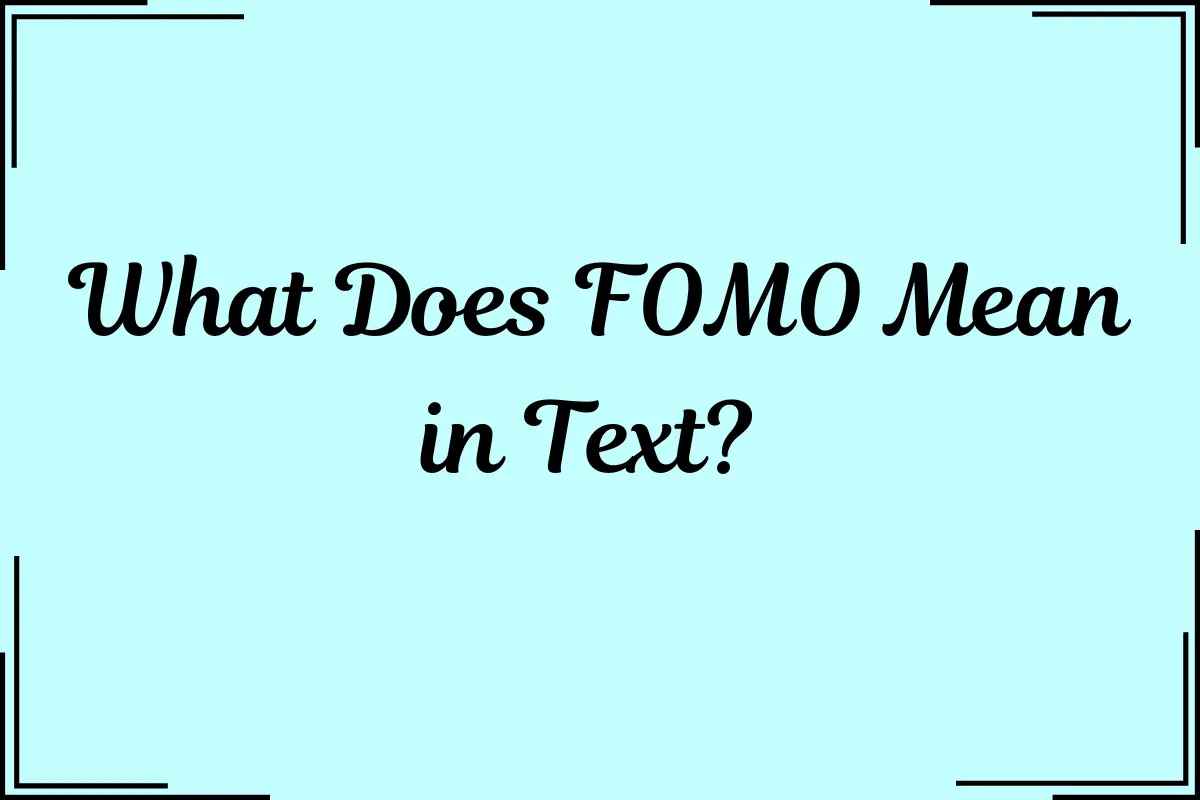Have you ever been lying on your couch, scrolling through your phone, and felt a sharp pang of regret that you weren’t out there doing something amazing?
That anxious, restless feeling has a name: FOMO.
But what does FOMO mean in text, and why is everyone talking about it?
Whether you’ve seen it in a friend’s message, an influencer’s Instagram caption, or a viral tweet, FOMO has become part of the way we talk about life online—and offline.
In this guide, you’ll learn:
- Exactly what FOMO stands for
- Why it resonates with so many people
- How it shows up in messages and social posts
- The psychology behind it
- Tips to manage it in healthy ways
- Pop culture examples that bring it to life
Ready to decode FOMO once and for all? Let’s jump in.
What Does FOMO Mean in Text?
FOMO is an acronym for Fear Of Missing Out.
Put simply, it’s that uneasy feeling you get when you suspect everyone else is having more fun, living a better life, or experiencing something valuable—while you’re stuck on the sidelines.
Here’s what FOMO might look like in real text conversations:
- “Everyone’s at the game without me—total FOMO right now.”
- “Stop posting those vacation pics. My FOMO can’t handle it!”
- “I can’t go to brunch, but I’m already getting FOMO.”
Related keywords:
✅ FOMO meaning
✅ What does FOMO stand for
✅ Fear Of Missing Out texting slang
Where Did FOMO Come From?
While it feels like a product of the Instagram age, FOMO is older than you might think.
Timeline of FOMO’s rise:
| Year | Milestone |
|---|---|
| 2004 | Patrick J. McGinnis first coined “Fear Of Missing Out” in Harvard Business School Magazine. |
| 2010s | Social media platforms like Facebook and Instagram became widespread, fueling comparison culture. |
| 2013 | The Oxford English Dictionary officially added FOMO to its entries. |
| 2010s–2020s | The term exploded into marketing, psychology, and everyday conversation. |
Today, it’s so common that it’s hard to remember a time before we had a word for this feeling.
What Makes FOMO So Powerful?
According to a 2017 survey by Eventbrite:
✅ 69% of Millennials experience FOMO regularly.
✅ 60% make reactive purchases to avoid missing out.
So why does it affect so many people?
Here are the main psychological drivers behind FOMO:
- Social comparison: We instinctively measure ourselves against others.
- Scarcity mindset: We think opportunities are limited and slipping away.
- Belonging needs: We crave connection and fear exclusion.
- Highlight reels: Social media only shows the best moments, not the struggles.
This combination can create an emotional cocktail of anxiety, envy, and urgency.
How FOMO Shows Up in Text and Social Media
You’ll see FOMO in countless forms, from casual chats to marketing campaigns.
Examples of FOMO in text messages:
✅ “Don’t tell me how good the concert is—serious FOMO here.”
✅ “Wish I was there. FOMO is real.”
✅ “Everyone’s talking about that new show. I have FOMO for sure.”
Examples on Instagram and TikTok:
- “Giving everyone major FOMO right now 🌴✨”
- “Sorry, not sorry for the FOMO pics.”
- “My weekend plans: stay in bed and try not to feel FOMO.”
Related Slang Terms to Know
FOMO isn’t alone—here are other popular terms you might see in texts:
| Acronym | Meaning |
|---|---|
| JOMO | Joy Of Missing Out (feeling happy to stay home) |
| YOLO | You Only Live Once (do everything!) |
| FOJI | Fear Of Joining In (the opposite—anxiety about participating) |
| FOMOMO | Fear Of the Mystery Of Missing Out (wondering what’s happening) |
Example text combining slang:
“Honestly, I’m embracing JOMO tonight. No FOMO, just cozy vibes.”
FOMO Across Cultures
While FOMO is universal, different cultures experience it differently:
🌏 United States & UK: Strong emphasis on individual success and experiences.
🇯🇵 Japan: Group belonging is key—missing gatherings can feel like social failure.
🇧🇷 Brazil: Social events and celebrations are deeply valued, increasing FOMO pressure.
🇩🇪 Germany: FOMO exists but is balanced by valuing work-life separation.
Adding this context helps us see that FOMO isn’t just an English-language trend—it’s a global phenomenon.
Real World Statistics That Show FOMO’s Reach
📊 Key data about FOMO:
- 56% of social media users experience FOMO regularly.
- Nearly 3 in 4 Millennials say they’ve made impulse purchases because of FOMO.
- More than half of smartphone users check their devices within 5 minutes of waking up—often to avoid feeling left out.
(Stats: Eventbrite, 2017; GlobalWebIndex, 2019)
Pop Culture References That Prove FOMO Is Everywhere
🎵 Music:
- “No FOMO” by Matoma celebrates living in the moment.
🎬 TV Shows:
- Broad City and Girls both depict characters obsessed with social plans.
📚 Books:
- The Joy of Missing Out by Tonya Dalton offers strategies to counteract FOMO.
🎤 Stand-Up Comedy:
- Comedians often joke about the stress of seeing everyone’s “perfect” lives on Instagram.
The Positive Side of FOMO
While FOMO often feels negative, it can also inspire growth:
✅ Motivation to try new things (“I don’t want to miss out next time.”)
✅ Increased social connection (“Let’s plan something together.”)
✅ Greater curiosity and learning
When managed well, FOMO can push you to step out of your comfort zone.
Action Plan: How to Handle FOMO
Here’s a step-by-step guide to manage FOMO in a healthy way:
Step 1: Pause & Acknowledge
Notice the feeling and name it—“I’m experiencing FOMO.”
Step 2: Reframe
Remind yourself: you’re seeing a highlight reel, not reality.
Step 3: Practice Gratitude
List 3 things you appreciate about your own life right now.
Step 4: Disconnect
Take a short break from social media (even an hour helps).
Step 5: Take Action
Make plans that excite you instead of dwelling on what you missed.
Expert Insight
💬 Dr. Andrew Przybylski, Oxford Internet Institute:
“FOMO is driven by the perception that others are having more rewarding experiences. The antidote is feeling that your own life is satisfying.”
Including expert voices helps validate that FOMO is a recognized psychological experience.
FAQs About FOMO
Q: Is FOMO a mental health disorder?
A: No, but chronic FOMO can lead to anxiety and depression if unmanaged.
Q: Can you have FOMO without social media?
A: Absolutely. Hearing about events, seeing photos, or even workplace updates can trigger it.
Q: Is JOMO the opposite of FOMO?
A: Yes—JOMO is the Joy Of Missing Out, or feeling peace with staying in.
Quick Recap
✅ FOMO = Fear Of Missing Out
✅ Common in text, social media, and marketing
✅ Driven by comparison and scarcity mindsets
✅ Manageable with mindfulness and gratitude
Conclusion: Embrace JOMO and Live Fully
Now you know exactly what FOMO means in text and why it resonates with so many people.
Remember—social media is only a slice of someone’s life, not the full picture. If you feel the tug of FOMO, take a breath, appreciate your present, and know that you are exactly where you’re meant to be.
👉 Your turn: Have you ever had a big case of FOMO? Share your story in the comments or tag us on social media. Let’s turn comparison into connection.











